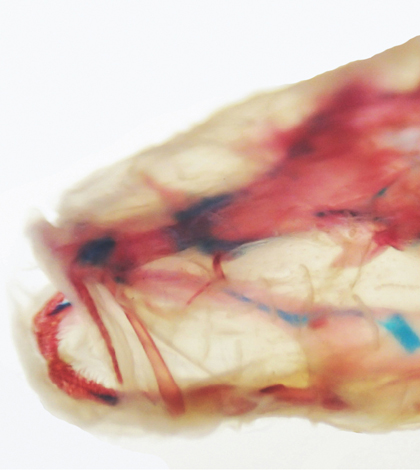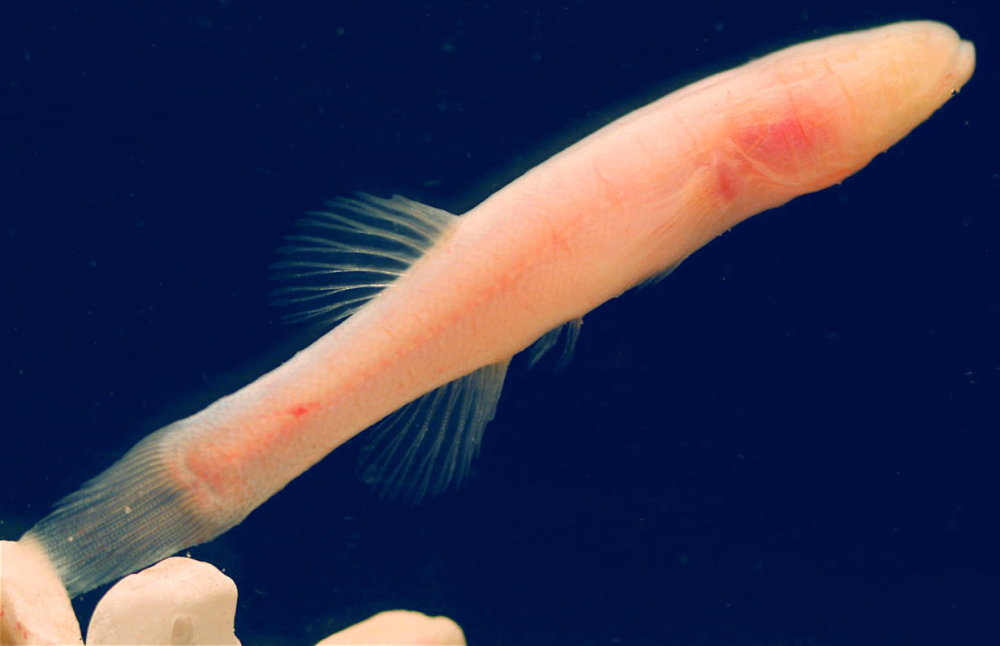Hoosier cavefish is the first new cavefish described from U.S. in 40 years

Image of a cleared and stained Hoosier cavefish, showing a lack of eye or a clearly defined bony orbit.
It’s not every day that the world’s caves reveal a new species. The creatures that crawl, swim and burrow through the hidden reaches of the Earth don’t often come to the surface. But sometimes they can be found hiding in plain sight.
Three biologists discovered a new species of cavefish by examining genetic, geographic and morphological variations within the existing genus Amblyopsis. The species A. hoosieri, known also as the Hoosier cavefish, is the first new cavefish to be described from the U.S. in 40 years.
“The clues came from my co-author [Matthew Niemiller],” said Prosanta Chakrabarty, assistant professor at Louisiana State University. “What he found through DNA analysis is that there are some really weird differences between cavefishes north and south of the Ohio River.”
The species was named for its proximity to Indiana University, an institution famed for spearheading ichthyology in North America. David Starr Jordan — often regarded as the father of North American ichthyology — and Carl and Rosa Eigenmann taught at the university. Rosa is considered to be the first woman in ichthyology.
Previous research failed to distinguish A. hoosieri from its closest relative. The new study looked at 41 specimens dating back to the 1800s, and found that the two species are distinctly separated by the Ohio River. A. hoosieri resides north of the river in Indiana, while A. spelaea makes its home in Kentucky’s Mammoth Cave.
“These species were separated probably during the last glacial period,” Chakrabarty said. “They’re going on their own evolutionary trajectories independently.”
At first glance, the Hoosier cavefish looks otherworldly, not unlike the chest-bursting alien of 1970s sci-fi fame. The tiny fish is pale and fleshy, with no eyes and a cloaca — an opening for excretion and egg-laying — located just behind the underside of its head. Females of the species, literally unable to keep an eye on their young, brood the fry in their gill chambers.

The newly described Hoosier cavefish (Credit: Matthew Niemiller)
Neither A. hoosieri or its relative A. spelaea have much use for eyes in their cave habitats, but genetic analysis reveals that A. hoosieri possesses an evolutionary leftover: a functional vision gene. Sensory papilla protruding from the cavefishes’ bodies allow the cavefish to sense motion in the surrounding water.
“You can catch these guys in your hands,” Chakrabarty said. “Not because they can’t see you, but because they’re not used to predators.”
Chakrabarty said that while A. spelaea was already endangered, splitting the species in two through redesignation amplified the situation.
“People might have thought, ‘We can lose a cave here or there,’” Chakrabarty said. “But that’s not the case — these habitats are really rare.”
“Certainly these are species that should be recognized as distinct, and recognized as something we need to protect individually,” Chakrabarty said.
Image: Image of a cleared and stained Hoosier cavefish, showing a lack of eye or a clearly defined bony orbit.





0 comments